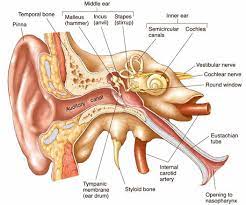The Normal Ear
In its typical express, the Eustachian tube stays shut, yet it will open when you yawn, swallow, bite, or hold your nose and blow. The reason for the Eustachian tube is to give natural air to the center ear space and to balance pressure between the external ear and the center ear. At any point can't help thinking about why your ears "pop" when you go up or down in a plane or a lift in a tall structure? That sound is your Eustachian tube(s) opening and shutting to balance the gaseous tension in your ears. The cochlea is comprised of three compartments (scala tympani, scala media, scala vestibule) that are isolated from one another by two films (basilar layer and Reissner's film). A little (organ of Corti) sits on top of the basilar film. This organ contains hair cells, which convert the mechanical energy from the vibrations of the basilar film into electrical motivations ear canal structure.
How We Hear?
The pinna gets sound waves and channels them down the outside hear-able canal, where they hit the tympanic layer and make it vibrate. Those vibrations cause the three ossicles to move. The stapes footplate pushes on the oval window layer, which gets the cochlear liquid underway. This wave-like movement makes the basilar film vibrate. As the basilar film goes here and there, the small "hairs" (stereocilia) on top of the hair cells open and near change the electrical charge of the cell. This outcome in an arrival of synthetic substances (synapse), which signals hear-able nerve strands to fire. The hear-able nerve sends these motivations up to the mind, where the sign is deciphered as solid.
Outer Ear
The external ear is the segment of the ear that can be seen by easygoing investigation. It comprises the pinna (what we for the most part called the 'ear'), which is connected to a bowl-formed construction called the concha. The concha closes at the ear canal, most effectively called the outer hear-able meatus. The ear canal closes at the eardrum (the tympanic layer), which fills in as the limit between the external and center ears. The external ear enhances the level of certain sounds because of its actual properties. Having two ears (one on each side of the head) implies that sounds showing up at the ears might vary in level or timing – signals utilized by the cerebrum to figure out where the sound is coming from.
Ear Drum
The mammalian external, center, and internal ears have distinctive early-stage beginnings and developed at various occasions in the vertebrate heredity. The external ear is gotten from the first and second branchial curve ectoderm and mesoderm, the center ear ossicles are gotten from neural peak mesenchymal cells that attack the first and second branchial curves, though the inward ear and its related vestibule-acoustic (VIIIth) ganglion are gotten from the otic placode. In this part, we talk about ongoing discoveries in the improvement of these designs and depict the commitments of individuals from a Forkhead record factor family, the Foxi family to their development. Foxi record factors are basic for the arrangement of the otic placode, the endurance of the branchial curve neural peak, and the formative redesigning of the branchial curve ectoderm.
Sound Waves
The center and external ear create from the combination and redesigning of the first and second pharyngeal curves, which are loaded up with NCC, while the internal ear emerges from the otic vesicle found at first straightforwardly back to the dorsal segment of the second curve NCC stream. Investigation of center ear ossicle improvement originates before the distinguishing proof of NCC. The arrangement of the center ear ossicles from the first and second pharyngeal curves was portrayed at first via Carl Reichert in his fundamental relative anatomical investigation of pig, bird, and frog nearly two centuries prior.

Comments
Post a Comment